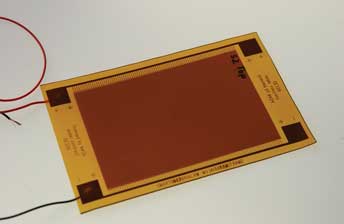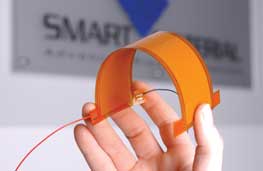|
|
 |

|
 |

|
 |
 |
‘NASA Invention of the Year’
Controls Noise and Vibration
Industrial Productivity
Originating Technology/NASA Contribution
Developed at NASA’s Langley Research Center, the Macro-Fiber
Composite (MFC) is an innovative, low-cost piezoelectric
device designed for controlling vibration, noise, and deflections
in composite structural beams and panels. It was created
for use on helicopter blades and airplane wings as well as
for the shaping of aerospace structures at NASA.
The MFC is an actuator in the form of a thin patch, almost
like a 3- by 2-inch bandage comprised of piezoelectric fibers,
an epoxy matrix, and polyimide electrodes, and is also called
a piezocomposite. If one applies a voltage to the MFC it
will stretch, and if attached to a structure it will cause
the surface to bend. The major advantages of a piezofiber
composite actuator are higher performance, flexibility, and
durability, compared to a traditional piezoceramic actuator.
MFCs consist of rectangular piezoceramic rods sandwiched
between layers of adhesive film containing tiny electrodes
that transfer a voltage directly to and from ribbon-shaped
rods that are no thicker than a few tenths of a millimeter.
These miniscule actuators are roughly equivalent to human
muscles—flexing, stretching, and returning to their original
position when electricity
is applied.
Because any external mechanical deformation of an MFC package
produces a charge on the electrodes proportional to the deflection,
its compression or stretching also enables the MFC to be
used as a self-powered sensor. Defects within structures
can therefore be detected, or small amounts of energy can
be collected and stored for later use.
|
The
Macro-Fiber Composite’s flat profile and use as a
sensor and an actuator allows for use in critical
or tight areas where other technologies with larger
volumetric profiles cannot be used. |
The MFC’s combination of small size, durability, flexibility,
and versatility allows it to be integrated—along with highly
efficient electronic control systems—into a wide range of
products. Potential applications include sonar; range-measuring
and fish-finding equipment; directional-force and fingerprint
sensors; flow meters; and vibration/noise control in aircraft
and automobiles. Since its original development in 1999,
the MFC has been used in government and industrial applications
ranging from vibration reduction to structural health monitoring.
NASA has used MFC piezocomposites for alleviating tail buffeting
in aircraft, controlling unsteady aerodynamics and noise
on helicopter rotor blades, and actively reducing vibrations
in large deployable spacecraft structures. The MFC has been
used as a sensor for impedance-based health monitoring of
launch tower structures at NASA’s Kennedy Space Center, for
strain feedback sensing and control in industrial arc welding
equipment, in an STS-123 experiment, in solar sail technology,
and in ultra-lightweight inflatable structures.
The MFC has been internationally recognized for its innovative
design, receiving two prestigious “R&D 100” awards in
2000, including the “R&D Editor’s Choice” award as one
of the 100 most significant technical products of the year.
The MFC was also the recipient of the International Forum’s
prestigious “iF Gold” award, in Germany, for design excellence
in 2004. In March 2007, the MFC was awarded the title of
“NASA Invention of the Year.”
Partnership
Smart Material Corporation, of Sarasota, Florida, specializes
in the development of piezocomposite components. The company
licensed the MFC technology from Langley in 2002, and then
added it to their line of commercially produced actuators.
It now combines the Langley MFC’s piezoelectric properties
with the robustness and conformability of plastics to radically
extend the spectrum of commercial applications.
A NASA partnership gives a small company access to research
and technologies that allow it to compete with larger corporations.
According to Thomas Daue, with Smart Material Corporation,
“For a small business, it is almost not possible anymore
to spend the money for basic research in high tech products.
Licensing technology from the leading research facilities
in this country is a very cost effective way to become a
player in a new technology field. Many developments ready
for licensing at government-owned facilities have already
reached the proof of concept status, which would often cost
a small business or start-up millions of dollars.”
Smart Material Corporation is now marketing MFCs internationally,
with the majority of applications in the United States directed
at Federal government research projects or defense-related
government contracts. For example, Smart Material Corporation
currently sells the materials to Langley, NASA’s Jet Propulsion
Laboratory, and Marshall Space Flight Center, where they
are used as strain gauge sensors, as well as to the U.S.
Air Force and the U.S. Army.
Product Outcome
|
When
compared to standard piezoelectric systems, the MFC
is much more durable and provides increased unidirectional
control. Furthermore, the MFC is designed to be readily
integrated into a system as an add-on component or
integrated during manufacture. |
To date, Smart Material Corporation has sold MFCs to over
120 customers, including such industry giants as Volkswagen,
Toyota, Honda, BMW, General Electric, and the tennis company,
HEAD. The company also estimates that its customers have
filed at least 100 patents for their unique uses of the technology.
Smart Material Corporation’s main manufacturing facilities
are located in Dresden, Germany, in the vicinity of the Fraunhofer
Institute for Ceramic Technologies and Sintered Materials,
one of the world’s leading research institutes in the field
of advanced ceramics. Dresden is also the center of the German
semiconductor industry, and so provides crucial interdisciplinary
resources for further MFC refinement. In addition to its
Sarasota facility, the company also has sales offices in
Dresden and in Tokyo, Japan.
The company’s product portfolio has grown to include piezoceramic
fibers and fiber composites, piezoceramic actuators and sensors,
and test equipment for these products. It also offers a compact,
lightweight power system for MFC testing and validation.
Smart Material Corporation believes that solid-state actuator
systems, including piezoceramics, will have healthy commercial
growth in the coming years, with increasing penetration in
industrial, medical, automotive, defense, and consumer markets.
Consumer applications already on the market include piezoelectric
systems as part of audio speakers, phonograph cartridges
and microphones, and recreational products requiring vibration
control, such as skis, snowboards, baseball bats, hockey
sticks, and tennis racquets.

|
|
 |
|


